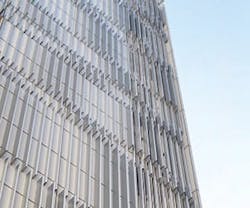Daylighting provides undeniable benefits to building occupants, but the accompanying solar heat gain and glare introduce issues of their own. It can be hard to bring in the right amount of light while moderating the heat.
Shading systems can help users find a healthy balance by blocking out the excess sunlight, but there’s more on the market than the roller shades or venetian blinds that typically come to mind first. External shading in particular can be a useful solution for reducing cooling demand and energy consumption because it directs solar heat away from the building before it has a chance to enter, says Irene Pau, a senior building envelope physicist in the facades team of Arup Facades’ Los Angeles office.
Could your building use better balance between natural light and unwanted heat? Compare it with these variables to determine whether exterior shading is a potential solution for your facility.
Examine Exterior Shading
Compared to external devices, internal shading is more readily available, generally easy to retrofit, and useful for blocking direct sunlight and cutting down on glare, but because solar heat is still entering the building, more mechanical cooling is required to compensate. Integrated shading built into glazing is also available and generally saves more energy than internal shading, Pau says, but it tends to be more expensive and presents maintenance issues with moving parts.
“With external shading, glazing can potentially be clearer, which improves the aesthetics of the building,” says Pau. “If there were no exterior shading devices, the glazing would have to do more work by being darker or more reflective, or the glazing area would need to be reduced.”
Exterior shading devices tend to fall into one of three categories:
Angle-dependent: This category includes fins, overhangs, and variations such as brise soleil or louvers. Their effectiveness depends on their depth, spacing, and response to the sun’s various angles at different times of the day and year, says Pau. Angle-dependent devices generally allow more visibility than uniform shading.
Uniform: Typically crafted from perforated metal mesh or fabric screens, uniform devices sit parallel to the facade, usually just in front of it. The amount of shading provided stays fixed regardless of the angle of the sun.
Kinetic: Also known as responsive shading, these devices automatically adjust to the sun to minimize solar gain and glare. One project, the Al Bahar Towers in Abu Dhabi, utilizes a curtainwall made of kinetic panels that open and close in response to the movement of the sun.
“The Al Bahar Towers project is pretty close to having an ideal shading setup,” explains Pau. “The kinetic shading devices helped reduce overall solar heat gains by about 50%.”
Pick the Best for Your Building
First, examine how your building’s unique characteristics affect which shading solutions will work best, Pau recommends.
“The site location is one of the first considerations because it defines the climate, local customs, and industry capabilities or limitations,” explains Pau. “For example, are there hurricanes to contend with? What level of solar gains are we dealing with and how much do we need to cut down by? Are we limited by certain materials that area contractors feel more comfortable working with? Do certain shading devices fit in better with the local building vernacular?”
PageBreakThe building’s orientation is also an important factor because different orientations experience the sun in different ways, Pau adds.
“An east-facing window receives direct morning sun, so perhaps a more uniform shading device makes more sense than an overhang,” says Pau. “If we wanted to open up the east facade after the morning sun has passed, then perhaps an internal roller or venetian blind would be more suitable. On the south facade, having an overhang could shield high-angle summer sun while letting in beneficial solar gains from the low-angle sun in the winter.”
Window size and the weight of shading devices also limit your choices – some shading products may not be available in large enough sizes for bigger windows, and you need to make sure your building can handle the added weight.
To help narrow down the options, Pau recommends gathering input from building occupants on what does and doesn’t work about your current setup. Ask them to weigh in on which areas need improvement, Pau says: “For example, limiting solar heat gain, cutting down on glare, or having more personal control over their environment.”
After the Installation
The upkeep for external shading varies widely by the type of device you chose, notes Bruce McKinlay, project director for Arup.
Fixed shading devices generally have a service life of 25-35 years, similar to other facade components, while fabric shades last closer to 15-20 years.
“Automated and operable shading devices have the lowest service life and require the most maintenance,” McKinlay explains. “Lifecycle costs vary significantly but are ultimately evaluated by comparing the energy cost savings and HVAC equipment reduction to the additional first cost and maintenance cost of the shading device. However, an exterior shading device is selected to allow greater transparency while maintaining good energy efficiency and occupant comfort.”
Janelle Penny [email protected] is senior editor of BUILDINGS.
About the Author
Janelle Penny
Editor-in-Chief at BUILDINGS
Janelle Penny has been with BUILDINGS since 2010. She is a two-time FOLIO: Eddie award winner who aims to deliver practical, actionable content for building owners and facilities professionals.

